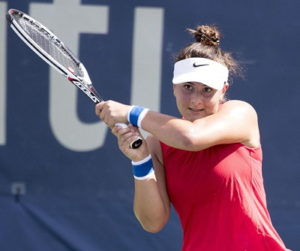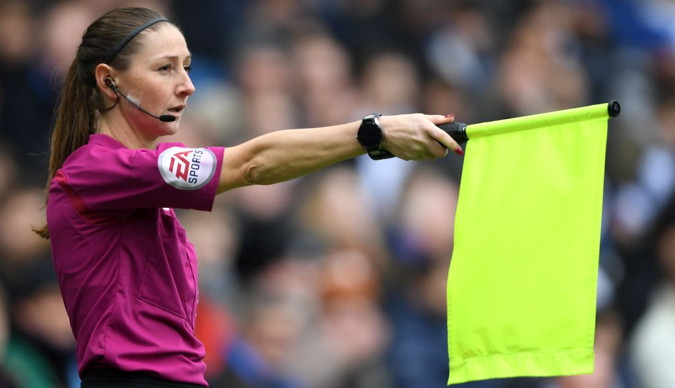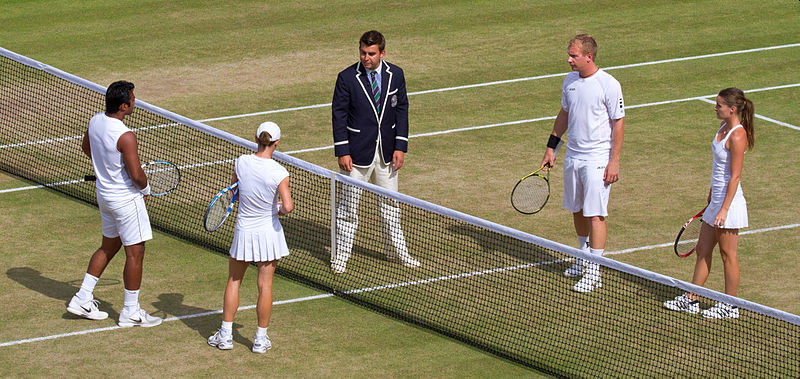Why Can’t Men & Women Compete Together In Most Sports?
 There are very few sports in which men and women compete together on an equal footing. The likes of football, tennis and rugby all have women’s versions of the sport, but they do not see the genders cross to create mixed teams on a regular basis or, in the case of tennis see men and women face one another in singles matches. This is largely down to the unfairness in their physicalities, given the fact that male rugby players are more likely to cause injury to their female counterparts if they tackled them in a game against them.
There are very few sports in which men and women compete together on an equal footing. The likes of football, tennis and rugby all have women’s versions of the sport, but they do not see the genders cross to create mixed teams on a regular basis or, in the case of tennis see men and women face one another in singles matches. This is largely down to the unfairness in their physicalities, given the fact that male rugby players are more likely to cause injury to their female counterparts if they tackled them in a game against them.
There are sports in which women and men compete on an equal footing, such as darts and horse racing, but there remain far fewer women taking part in those sports in that capacity than there are women competing in the sports in general. The women’s versions of the majority of sports are increasing in popularity year-on-year, yet the main popularised versions of them are dominated by men and that doesn’t look like changing any time soon. Is there a world in which men and women should be allowed to compete together in all sports?
Physical Differences In Tennis

Keith Allison from Hanover, MD, USA, CC BY-SA 2.0, via Wikimedia Commons
The main reason given for why men and women don’t compete equally in some sports is their physical differences. In the majority of cases, the physiology of men is such that they are taller, bigger and stronger than their female counterparts. That doesn’t mean that there are no women that are as physically imposing as men, but that, most of the time, men are physically superior to women. That is in the literal sense of the word ‘superior’, as opposed to the pejorative term in which it might be seen to suggest that men are ‘better’ than women.
Whilst this is true, it is often used as an excused and the reasoning can’t stand up to any sort of scrutiny. If we were to look at tennis as an example, when would the physicality of men be crucial to the success of male players over female ones? You could argue that a strong man would be able to serve faster than a woman, but is that true? According to Tennis Companion, the fastest male service comes from Australian Sam Groth, who stands at six foot four inches and served at 263 kilometres per hour in the 2012 Busan Open.
In comparison, Spanish player Georgina Garcia Pérez served a ball at 220 kilometres per hour in 2018 and stands at six foot two inches. The list of men’s servers goes to 20, with six players able to serve the ball at 230 kilometres per hour, which is ten kilometres per hour faster than the fastest female counterpart. A look at the list of names, though, shows that there are some big names missing from it. Andy Murray isn’t in the top 20, for example, whilst Novak Djokovic is also missing. Roger Federer is there, but would be the first to admit that first serves weren’t an important part of his game.
There is also information from Tennis Companion about the average speed as well as the median speed and the range of speeds from players on tour, in addition to the player height. Here’s a look for men and women:
| Stat | Male | Female |
|---|---|---|
| Average Speed of Fastest Serve | 238 kilometres per hour | 203 kilometres per hour |
| Median Speed of Fastest Serve | 235 kilometres per hour | 202 kilometres per hour |
| Serve Speed Range | 230 – 263 kilometres per hour | 201 – 220 kilometres per hour |
| Player Height Range | 175 – 211 centimetres | 144 – 188 centimetres |
It is fair to say that the evidence is there to suggest that men can serve the ball faster than women, but does that immediately mean that the two genders shouldn’t mix? There have been plenty of fast-serving women in the past who have competed on an even playing field with their competitors. Serena Williams is one of the best tennis players of all time, but her fastest speed is around 14 kilometres per hour slow than that of Georgina Garcia Pérez. It is unlikely that Williams will have been cowed at the possibility of facing such a fast serve.
Whilst this is specific for tennis, it is a good example of how a decision has been made to stop men and women from competing on an even footing because of perceived inferiority on a physical level. Though Margaret Court lost to Bobby Riggs in the ‘Battle of the Sexes’ in May 1973, Billie Jean King defeated him a few months later. Martina Navratilova lost to Jimmy Connors in 1992, but Connors needed a tie-break to take the second set from his opponent. If women were allowed to compete equally with men, they would likely win more often.
Football

Though the physical demands of games like rugby are clear to see, there is perhaps an exaggeration when it comes to the likes of football. Yes, defenders in the men’s game are built in such a way that they are able to be physically imposing on the opposition, but does that automatically mean that women would struggle to compete with them on a level playing field? Lionel Messi is the best football player of all time, yet stands at just five foot seven. He wasn’t competing for headers with players that stand at six foot four inches.
Instead, his low centre of gravity alongside his skill with the ball meant that he could nip past such tall, lumbering defenders and put the ball into the back of the net. In 520 league appearances for Barcelona, he scored 474 times. At no point did his size prove to be a negative for him when he was achieving such feats. Finishing his time in Spain with ten La Liga titles, four Champions Leagues and seven Ballon d’Or trophies to his name. What logical reason is there for a talented female player to not be able to be just as successful?
There will doubtless be some that point to the level of the women’s game in comparison to the men’s, but what a lot of people might not realise is that the women’s version of the game was as popular as the men’s game during football’s more formative years. In the early 1920s, women’s football was hosting international games and attracting sell-out crowds at stadiums, which was nearly a decade before those taking part in the games had even been allowed to vote. More than 53,000 people turned up to Goodison Park to watch Dick Kerr’s Ladies on Boxing Day in 1920, for example.
As proof of how influential the women’s game was, that Boxing Day game raised about £3,000 for charity, which is the equivalent of around £40,000 in today’s money. Had the two versions of the game been allowed to develop alongside one another, the women’s game would doubtless be as popular and successful as the men’s, as well as played to the same level. Instead, in 1921, the Football Association banned women from playing the game on Football League grounds. The FA Council said the following on the matter:
“The game of football is quite unsuitable for females and ought not to be encouraged.”
The ban wasn’t lifted until 1971, but 50-years’ worth of damage had been done in that time. What female Lionel Messis might have been missed because women were not allowed to play the game in the same way as men during that time? It is interesting that in England, for example, the women’s England team has won the European Championship before the men’s team has been able to win the same competition. There are plenty of women that are equally as talented, if not more so, as their male counterparts, but aren’t allowed to compete on the same level.
Even until lately women were excluded largely from officiating too. Only in recent years have we seen women running the line and at the time of writing we are yet to see a female referee in the Premier League. There can be no argument that women are not physically capable of officiating compared to men to the bias until now has been entirely down to the attitude of the rule makers.
Perhaps there is a a belief that a woman would struggle on a pitch with 22 men but that in itself just further pushes the stereotype. There are plenty of women with a strong enough temperament to officiate a men’s football match, with arguments that they may actually be better than male referees.
Sports Where Men & Women Compete Equally
Whilst there are numerous examples of sports where men and women are not allowed to compete on a level playing field, there are also a fair number of sports where they do just that. One of the most obvious examples is horse racing, which has seen women compete professional since the 1970s. Meriel Tufnell became the first woman to win a race under the Rules of Racing when she partnered Scorched Earth to success in the Goya Stakes in 1972. That was the first time that women were allowed to race, with Tufnell retiring three years later.
In spite of Tufnell’s success, female riders faced an uphill battle to compete with men. This was largely because so few top rides were given to women. An analysis of the previous 14 raving seasons on both the flat and over jumps was carried out in 2018. It looked at more than one million rides and found that women competed just as well as men when they were allowed to ride horses of similar ability, but that far fewer top rides were given to female jockeys when compared with male ones. Women took about 9.5% of the lowest grade races and just one in 100 top-level rides.
There are lots of reasons for this, but it is worth pointing out that women and girls don’t necessarily see horse racing as a possible career path in the same way that men do. As a result, there are fewer riders for trainers to pick from, so they naturally turn to men on a more regular basis. The glass ceiling in the industry is being broken all of the time, such as when Rachael Blackmore made history by becoming the first female jockey to win the Grand National in 2021, having already become the first woman to be named Leading Jockey at the Cheltenham Festival and the first women to win the Cheltenham Gold Cup.
Darts

Sven Mandel, CC BY-SA 4.0, via Wikimedia Commons
In 2019, Fallon Sherrock made headlines and history when she became the first woman to win a match at the World Darts Championship. She did so by defeating Ted Evans in the first round, but when she also defeated the then-world number 11, Mensur Suljovic, in the second round, the headlines grew even more vociferous. In September of 2021, Sherrock made to the final of the Nordic Darts Masters, losing out to Michael van Gerwen who was full of praise for her, saying, “She was phenomenal the whole tournament. She’s a top talent not only for women’s darts but for the whole sport of darts.”
That doesn’t mean that women can only compete with the men. There are women’s tournaments that are dominated by some top players in the Professional Darts Corporation that try to compete with them men. As with football, horse racing and most other sports, the issue for women isn’t about talent as much as it is about opportunity. When the World Darts Championship took place in 2021, for example, there were just two spaces open to women who had to qualify via the Women’s Series, with 94 men able to compete.
Why Don’t The Genders Compete Together?

Bo Mertz, CC BY-SA 2.0, via Wikimedia Commons
For too long, professional sports has been seen as a male only environment, meaning that female players of pretty much any sport have not enjoyed the same focus and funding as their male counterparts. There is no logical reason why women couldn’t play in the Premier League, for example, if they were given the same money and training as men. Similarly, if the make-up of the world’s best darts competitions was 50% of each gender, why wouldn’t women be able to win the titles on a fairly regularly basis in the same way that men have?
Whether you talk about sailing or motor racing, badminton or ice skating, there has been a desire amongst the powers that be to keep men and women separate for the purposes of sporting endeavour. As we know from football, it isn’t that the women’s version of the sport is less popular than the men’s, given that more than 17 million people tuned in to watch the final of the Euros in 2022. Instead, sexism, pure and simple, has stopped women from getting the same chances to develop as men, which, in turn, has stopped them from being able to compete shoulder-to-shoulder.




